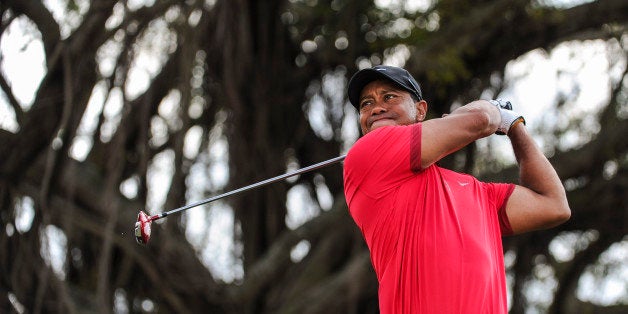
It sounds like an April Fools' Day joke, but it isn’t. Tiger Woods doesn’t much talk about his injuries, so it follows his inner comic wouldn’t weigh in about something as serious as spinal health.
Woods again dominated golf headlines Tuesday for reasons other than performance, a trend of late. Once again his spine was in the spotlight, never good for a professional athlete.
For Woods that meant Monday microdiscectomy surgery to fix a pinched nerve in his back, a procedure that knocks him out of next week’s Masters. The news is surprising because it comes a week before the year’s first major championship, and smart money had figured he’d play there if he had to crawl to the first tee. Dumb money might not be right in Las Vegas, but it was here.
The fact that Woods didn’t defer surgery until after the Masters probably means a couple of things. One, he’s more interested in long-term health than next week. Two, he wasn’t ready for Augusta National, given his physical condition, recent inactivity and inconsistent performance in 2014.
The screaming news means plenty more, big picture and small. Yes, the Masters loses some buzz and the tournament won’t have the same vibe sans Woods. But the most important thing is a return to health – particularly for someone who, at 38, maintains he has a lot of good years left.
Fixing the problem, a.k.a. Job One, equates to taking two or three steps back in order to go 10 miles forward. The average recovery from that operation for an elite athlete is 3-4 months, doctors say. If it’s three months, he would miss the U.S. Open in June. If it’s four, he would skip the Open Championship in July.
But if you listen further to the medical community, there’s apparently bright news ahead for Woods. Full recovery is likely, said Dr. Andrew Hecht, chief of spine surgery at the Icahn School of Medicine at Mount Sinai Hospital in New York.
Hecht said he has performed more than 1,000 microdiscectomy surgeries over 14 years, including on many top athletes.
“The ones I’ve done with pro, college and Olympic athletes, everybody has gone back to same elite level of competition,” said Hecht, also spine-surgical consultant for the New York Jets and Islanders. “So Tiger’s likelihood of returning to the same level of play is very high. The key is rehab, but the odds are in his favor.”
Hecht got no dissent from Dr. David Geier, an orthopedic surgeon and sports-medicine specialist in Charleston S.C.
“You never know for sure how it will take, and sometimes it depends on how long the pressure on the nerve lasted,” Geier said. “But somebody in his athletic condition, there’s no reason to expect he can’t get back to the same level as before.”
On the other hand, the odds of the 14-time major winner breaking golf’s most coveted individual record – Jack Nicklaus’ 18 major titles – are not in his favor. That was the case before his back acted up again a few weeks ago. That was even the case in January, when Woods was coming off a five-victory PGA Tour season and heading into a year in which the majors set up for him beautifully.
Yes, Woods has won at three of the four 2014 major venues and has come close twice at the other, Pinehurst No. 2. But that edge apparently is gone now. No Masters. Perhaps no U.S. Open. Maybe no Open Championship. Then factor in time needed to get sharp again.
The only way it doesn’t become a lost season, at least in terms of major medals, is if he recovers quickly and can play the last three majors at full strength. In that case, by having surgery he’d be giving up one major in order to have a chance in three.
What hasn’t changed, though, is that Woods still needs the five-major career of Phil Mickelson or Seve Ballesteros to pass Nicklaus. That’s a tall order for someone who turns 39 in December, even if that someone is named Tiger Woods, particularly considering he has had knee, Achilles, neck and back problems in the past six years. There’s no guarantee his body will cooperate enough to allow him to prepare properly, much less win in bunches. Plus, the competition has steadily grown stronger since he last won a Grand Slam event, in 2008.
On the other hand, though he’s not as good as he was in his pre-2010 prime, Woods always is dangerous when he can put the club in the right place, and doing so pain-free. We saw that in low Saturday rounds at the Honda and Cadillac tournaments this year, only to be followed by Sunday back issues each time. We saw that in his eight victories in 2012-13.
It’s uncertain what caused his back problems – the occupational hazard of twisting and turning while swinging over decades, or his famously rigorous workouts. But that doesn’t matter. What does is that he needs to be more careful in the gym and modify his training, if not swing, to take pressure off his back.
When the news broke Tuesday, I couldn’t help but think back to the 2013 PGA Championship at Oak Hill. It was clear that his back tightened up several times there. But when asked if the back was a long-term concern, he scoffed and said no.
Everybody knows better today. A couple of weeks after the PGA, his back faltered at The Barclays. And now he will head into summer with a surgically repaired back, only 10 2014 PGA Tour rounds under his belt and surrounded by more questions than answers.
